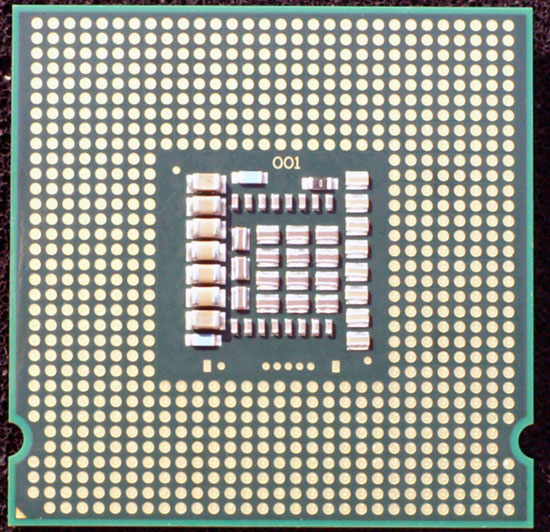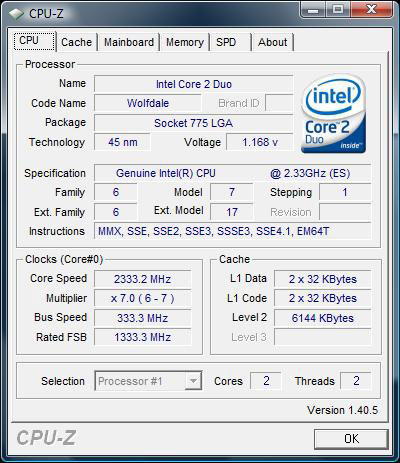The Penryn Preview - Part I: Wolfdale Performance
by Anand Lal Shimpi on August 21, 2007 12:35 PM EST- Posted in
- CPUs
Penryn's Launch Schedule
The launch will work like this: late this year (Q4), Intel will introduce a a new Extreme Edition processor based on Yorkfield (quad-core Penryn). Given that most Extreme Edition chips start out with a $999 price tag, that's where we'd expect the first quad-core Penryn to fall as well.
More affordable Penryn won't arrive until Q1 2008, which is great news for AMD. In the beginning of next year, Intel will introduce both mainstream Yorkfield and Wolfdale (dual-core Penryn) parts. We'd expect Wolfdale based chips to run at between 2.33GHz and 3.00GHz, while Yorkfield will probably top out at 3.33GHz.
In Q2 2008, Intel will push Penryn even further down the line and introduce a Wolfdale based E4xxx successor. This version of Wolfdale will have a 1066MHz FSB and drops support for Intel Virtualization Technology and TXT.
The Chip
Intel is keeping its few remaining cards close at hand, and thus it is only sampling lowly 2.33GHz Wolfdale/Yorkfield chips. It's not an issue of getting the 45nm process to clock high enough (as you'll see from our overclocking tests), so we'd guess that Intel doesn't want to have the performance of its top of the line 3.33GHz Yorkfield leaked until after Phenom hits.

Wolfdale's underside - we have to hide the other side so Intel doesn't murder our mole in its sleep

Conroe's belly for comparison
The 2.33GHz Wolfdale we're looking at today is best compared to the Core 2 Duo E6550 (2.33GHz Conroe), and that's exactly what we're doing.

Our Wolfdale is also not the final stepping that will be shipping next year; we've got A0 silicon and A1 should be ready in the coming weeks. Despite the not-final state of the silicon, we had absolutely no problems with the chip in our test bed. We tossed it in our Gigabyte GA-P35C-DS3R test bed and ran through a subset of our test suite without so much as a BIOS update. We are waiting on the first Penryn-tuned motherboards and BIOSes to arrive, so performance may increase from where we're at today.
The Test
| CPU: | Intel Core 2 Duo E6550 (2.33GHz/1333MHz) Intel Wolfdale 2.33GHz/1333MHz |
| Motherboard: | Gigabyte GA-P35C-DS3R (Intel P35) |
| Chipset: | Intel P35 |
| Chipset Drivers: | Intel 8.1.1.1010 (Intel) |
| Hard Disk: | Seagate 7200.9 300GB SATA |
| Memory: | Corsair XMS2 DDR2-800 4-4-4-12 (1GB x 2) |
| Video Card: | NVIDIA GeForce 8800 GTX |
| Video Drivers: | NVIDIA ForceWare 158.18 |
| Desktop Resolution: | 1600 x 1200 |
| OS: | Windows Vista Ultimate 32-bit |










55 Comments
View All Comments
Affectionate-Bed-980 - Thursday, August 23, 2007 - link
My God. Then maybe they should think about reviews when dealing with NDAs. Just because I didnt have to pay for this article doesn't mean people can't complain.Remember those Conroe reviews done by HardOCP or something that were just GPU limited? Of course people have a right to complain about crappy reviews.
Beenthere - Wednesday, August 22, 2007 - link
Nothing here but ad hype for sure. Intel looks desperate.AnnonymousCoward - Saturday, August 25, 2007 - link
Since when does a process node transition mean the company is desperate??fitten - Thursday, August 23, 2007 - link
Why would Intel be despirate? you think 2GHz Barcelona (which isn't the desktop chip) scares them?coldpower27 - Wednesday, August 22, 2007 - link
Assuming that a E6550 consumes 8-10W at idle and 55W at load which shouldn't be too far off from the proper numbers and is a reasonable estimate.
Then your looking at 3-5W for idle and something like 37W for load, very impressive considering the Wolfdale SKU's on the desktop are going to retain their 65W TDP.
n0nsense - Wednesday, August 22, 2007 - link
wtf ?32bit system performance tests on 64bit hardware ?
lets test it on PII.
if you can't find native 64bit soft for MS, look at real OSes.
need new optimizations ? compile open source programs with new flags enabled.
and one more thing.
compilation test will be very good
johnsonx - Wednesday, August 22, 2007 - link
Ever since this:http://www.dailytech.com/article.aspx?newsid=8313&...">http://www.dailytech.com/article.aspx?n...amp;thre...
I can't help but laugh when I see the first chart on page one.
strikeback03 - Wednesday, August 22, 2007 - link
bwahahaPenryn enhancements indeed
TA152H - Tuesday, August 21, 2007 - link
I somehow remember having an argument with all the dolts that were claiming massive IPC improvements for this core and how hopeless the Barcelona was since it would be against the Penryn. It surely does not look to be impossible to me, not even close. Considering the massive improvements AMD gets over time with their process technology, and large improvements vis-a-vis the K8, this looks to be the most competitive the companies have been for quite some time.Not that I am bad mouthing Intel, they did an amazing job not only increasing the size of the cache, but also lowering the latency. The problem is that so many people were expecting the impossible, and now are disappointed because they really don't know anything about microprocessors. It's not Intel's fault, it's still a great product. Lower power, better performance and smaller size compared to a fantastic processor is something they deserve a lot of credit for. But, it's not going to walk away from the Barcelona, especially on servers.
Higher clock speeds would probably show greater improvement, since it's got a larger cache, and going to four cores would as well, but the reality is, it's not going to be a big improvement on most apps. It's also going to be relatively simple for AMD to increase cache sizes, particularly since they added wait states to the L2 cache so it could be bigger if they chose (again illustrating how amazing Intel was for increasing size and speed).
By the time this processor is out though, AMD will not only have corrected the most egregious speed path problems for Barcelona, but they will also be further along on their 65nm process, and if history is any indication (and it normally is), AMD will do a great job in improving their manufacturing on 65nm. All in all, it's not going to be easy for Intel. Or AMD.
AbRASiON - Tuesday, August 21, 2007 - link
I believe those idiots were hopeful of extremely high clocks actually.It doesn't matter how performance is delivered, 10mhz of ultra optimised CPU or 10ghz of poorly optomised, all we want is speed and AMD is yet to show us the money.